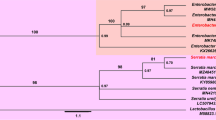Abstract
The entomopathogenic bacterium, Xenorhabdus nematophila was isolated from the hemolymph of Galleria mellonella infected with Steinernema carpocapsae. The bacterial cells and its metabolic secretions have been found lethal to the Galleria larvae. Toxic secretion in broth caused 95% mortality within 4 d of application whereas the bacterial cells caused 93% mortality after 6 d. When filter and sand substrates were compared, the later one was observed as appropriate. Similarly, bacterial cells and secretion in broth were more effective at 14% moisture and 25°C temperature treatments. Maximum insect mortality (100%) was observed when bacterial concentration of 4×106 cells/ml was used. Similarly, maximum bacterial cells in broth (95%) were penetrated into the insect body within 2 h of their application. However, when stored bacterial toxic secretion was applied to the insects its efficacy declined. On the other hand, when the same toxic secretion was dried and then dissolved either in broth or water was proved to be effective. The present study showed that the bacterium, X. nematophila or its toxic secretion can be used as an important component of integrated pest management against Galleria.
Similar content being viewed by others
References
Akhurst, R.J., Boemare, N.E., 1988. A numerical taxonomic study of the genusXenorhabdus (Enterobacteriaceae) and proposed elevation of the subspecies ofX. nematophilus to species.Journal of General Microbiology,134: 1835–1845.
Akhurst, R.J., Boemare, N.E., 1990. Biology and Taxonomy ofXenorhabdus.In: Gaugler, R., Kaya, H.K. (Eds.), Entomopathogenic Nematodes in Biological Control. C.R.C. Press, Boca Raton, Florida, p.75–90.
Akhurst, R.J., Dunphy, G.B., 1993. Tripartite Interaction between Symbiotically Associated Bacteria (Xenorhabdus spp) and Nematodes (Steinernenatidae andHeterorhabditidae) and Their Insect Hosts.In: Beckage, N., Thomson, S., Federici, B. (Eds.), Entomopathogenic Nematodes in Biological Control. Academic Press, Inc., New York, p.75–87.
Boemare, N.E., Givaudan, A., Brehelin, M., Laumond, C., 1997. Symbiosis and pathogencity of nematode bacterium complexes.Symbiosis,22:21–45.
Bowen, D.J., Ensign, J.C., 1998. Purification and characterization of the high-molecular-weight insecticidal protein complex produced by the entomopathogenic bacterium,Photorhabdus luminescens.Applied and Environmental Microbiology,64:3029–3035.
Dudney, R.A., 1997. Use ofXenorhabdus Nematophilus Im/l and 1906/1 for Fire Ant Control. US Patent, No. 5616318.
Elawad, S.A., 1998. Studies on the Taxonomy and Biology of a Newly Isolated Species ofSteinernema (Steinernematidae: Nematoda) from the Tropics and Its Associated Bacteria. Ph.D. Thesis, Department of Agriculture, University of Reading, UK.
Elawad, S.A., Gowen, S.R., Hague, N.G.M., 1999. Efficacy of bacterial symbionts from entomopathogenic nematodes against the beet army worm (Spodoptera exigua).Test of Agrochemicals and Cultivars No. 20. Annals of Applied Biology (Supplement),134:66–67.
Ensign, J.C., Bowen, D.J., Tenor, J.L., Ciche, T.A., Petell, J.K., Strickland, J.A., Orr, G.L., Fatig, R.O., Bintrim, S.B., ffrench-Constant, R.H., 2002. Proteins from the GenusXenorhabdus are Toxic to Insects on Oral Exposure. US Patent, No. 0147148 A1.
ffrench-Constant, R., Bowen, D., 1999.Photorhabdus toxins: novel biological insecticides.Current Opinion, in Microbiology,2:284–288.
Forst, S., Nealson, K., 1996. Molecular biology of the symbiotic-pathogenic bacteriaXenorhabdus spp. andPhotorhabdus spp.Microbiological Reviews,60:21–43.
Gotz, P., Boman, A., Boman, H.G., 1981. Interactions between insect immunity and an insect-pathogenic nematode with symbiotic bacteria.Proceedings of Royal Society London,212:333–350.
Kaya, H.K., Gaugler, R., 1993. Entomopathogenic nematodes.Annual Review of Entomology,38:181–206.
Mahar, A.N., 2003. The Efficacy of Bacteria Isolated from Entomopathogenic Nematodes against the Diamondback MothPlutella xylostella L. (Lepidoptera: Yponomeutidae). Ph.D. Thesis, Department of Agriculture, University of Reading, UK.
Mohan, S., Raman, R., Gaur, H.S., 2003. Foliar application ofPhotorhabdus luminescens, symbiotic bacteria from entomopathogenic nematodeHeterorhabditis indica, to kill cabbage butterflyPieris brassicae.Current Science,84:1397.
Poinar, Jr. G.O., 1979. Nematodes for Biological Control of Insects. C.R.C. Press, Boca Raton, Florida.
Poinar, Jr. G.O., Thomas, G.M., 1966. Significance ofAchromobacter nematophilus Poinar and Thomas (Achromobactereace: Eubacteriale), in the development of the nematode, DD-136 (Neoplectanta sp., Steinernematidae).Parasitology,56:385–388.
Samaliev, H.Y., Andreoglou, F.I., Elawad, S.A., Hague, N.G.M., Gowen, S.R., 2000. The nematicidal effects of the bacteriaPseudomonas oryzihabitans andXenorhabdus nematophilus on the root-knot nematodeMeloidogyne javanica.Nematology,2:507–514.
Author information
Authors and Affiliations
Corresponding author
Rights and permissions
About this article
Cite this article
Mahar, A.N., Munir, M., Elawad, S. et al. Pathogenicity of bacterium, Xenorhabdus nematophila isolated from entomopathogenic nematode (Steinernema carpocapsae) and its secretion against Galleria mellonella larvae. J Zheijang Univ Sci B 6, 457–463 (2005). https://doi.org/10.1631/jzus.2005.B0457
Received:
Accepted:
Published:
Issue Date:
DOI: https://doi.org/10.1631/jzus.2005.B0457
Key words
- Biological control
- Bacterial symbionts
- Entomopathogenic nematodes
- Xenorhabdus nematophila
- Galleria mellonella




